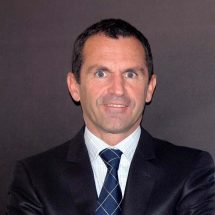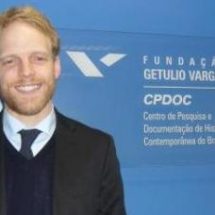Adriana Marcolini
July 7, 2012
Brazilian Journalist.
Biography
Adriana Marcolini has worked for newspapers such as O Estado de Sao Paulo and Gazeta Mercantil.
She worked as a correspondent for the Brazilian press in Argentina for several years.
In 2001 she served as a volunteer at the United Nations High Commissioner for Refugees (UNHCR) in Bosnia Herzegovina and in 2008 she worked for the International Committee of the Red Cross in Buenos Aires.
Ms. Marcolini published the guide 50 Livrarias de Buenos Aires (“50 Bookshops of Buenos Aires”) by Atelie Editorial (Sao Paulo, 2011).
In May 2012, Adriana has been conducting a number of interviews of skilled immigrant professionals who have moved to Brazil.
One of them is Oliver Stuenkel (pictured below), a German Assistant Professor of International Relations at the Getulio Vargas Foundation in Sao Paulo, a well-known private university in Brazil.
His research focuses on rising powers, specifically on Brazil’s and India’s foreign policy and their impact on global governance. During his interview, Stuenkel explained that while there are excellent Brazilian academics in the field of international relations, their number is too low, especially in light of how important the topic has become in Brazil in the last few years.
In June 2012, Adriana Marcolini recently interviewed Frédéric Ronflard, a French national who moved to Brazil in 2010 to open an office for the professional recruitment company Robert Walters.
“Many people in Europe want to leave the crisis and hear about opportunities in Brazil. Every day I receive between five and ten CVs from Europe, most of them from recent graduates or from professionals over 40. Unfortunately it has been difficult to help these people.”
Interview
Why does immigration reporting matter today?
According to the 2004 World Economic and Social Survey, an extensive report prepared in 2004 by the United Nations Department of Economic and Social Affairs, 175 million people live outside the country where they were born. This means that one out of 35 people is a migrant. This gives an idea of how broad the migration phenomenon is nowadays. I believe the press has an obligation to cover this phenomenon, regardless of the country.
Unfortunately there is a lot of misinformation around and this can lead easily to xenophobia. I also believe journalists should be very careful when writing (or preparing a TV report or radio news service) about migration because they are talking about human beings and they can easily destroy people’s lives if they don’t use the correct words or if they paint a certain group in a negative way.
Writing an article about the decrease in the economic activity is very different, for instance, because you are not directly involving people’s lives. I think it is important to stress that migration doesn’t affect only people leaving their home country to another one, but also people who are forced to leave their home town or region due to the construction of dams or to environmental problems.
These can either be natural disasters (example: [Hurricane] Katrina in the United States or the earthquake in Haiti) or provoked by bad policy conducted by the government or corporations, such as floods. Many times, floods are not “natural” phenomena, but are caused by bad urban or rural planning. And many people are forced to leave their homes.
What resources would you recommend on the topic? (articles,websites, video, movies, books, etc.).
I would recommend the UN report World Economic and Social Survey 2004. Also the International Organization for Migration (IOM) is a good source of information. They launch publications on a regular basis and it is possible to buy them online.
On refugee issues I recommend UNHCR’s website and the magazine “Forced Migration Review”, published by the Refugee Studies Centre in the Oxford Department of International Development, University of Oxford, England. This is a semi-academic review published in four languages and available for free online.
As for books, I strongly believe that reading novels can be a good approach to migration issues.
A few years ago I read a very touching book in English called Lost inTranslation: A Life in a New Language. The author is Eva Hoffman, a Polish-American writer who emigrated from Poland with her parents while still a teenager, first to Canada, and later to the US. The book brings her experiences as a Polish immigrant caught between divergent cultures and languages.
For those who read in Italian I recommend A Sud di Lampedusa, by Italian journalist Stefano Liberti, which is a good report on the arrival of African “potential immigrants” in southern Italy, and Quando Dio ballava il tango, by Italian writer Laura Pariani. This is an immigration novel written by the granddaughter of an Italian who immigrated to Argentina in the beginning of the 20th century, leaving his family back in Italy and never coming back. Ms. Pariani traveled to Argentina, tracing her grandfather’s footsteps and wrote a touching novel delineating Argentina’s history throughout the 20th century and interconnecting it with Italian immigration in that country.
As for a movie, I would recommend “Golden Door” (Nuovomondo, 2006), by Emanuele Crialese.
It is an excellent movie about the Italian emigration to the United States. The music is superb!!!
There is a preview of the movie on Youtube.
What makes an outstanding reporter?
I believe it is a “sixth” sense, that is, the sensitivity to approach certain issues that are not the “big issues” on newspapers covers. An outstanding reporter should always be alert to topics which are not usually covered by the press. In order to write interesting (and creative) articles, he/she should also investigate, research and talk to people, as part of his/her work.
I also believe that being humble and open to learn is an important attribute.
Who are your journalism inspirations?
Polish journalist Ryszard Kapuscinski (1932-2007), whom I had the honor to interview personally in Warsaw in December 1995, always inspires me.
He is my idol.
Some authors, such as the Colombian Gabriel García Marquez, also inspire me.
While on the ground, what is your most memorable anecdote?
I don’t remember any anecdote, but I do remember how nervous I was when I interviewed personally the former Italian prime minister, Mr. Romano Prodi. That was in July 1997 at the Palazzo Chigi, in Rome.
This is the official building of the Italian government, where the prime-minister and his staff work. It was summer and very hot, as summers are in Rome. I had taken a bus and walked a bit to arrive to Palazzo Chigi and was very thirsty. His press officer received me at the entrance. When we entered Mr. Prodi’s office he was very kind, but didn’t offer anything (a cup of coffee or some water).
I thought I couldn’t start the interview without drinking a glass of water, so I kindly asked for one. He picked up the phone and ordered it, and then a man came inside with two glasses (one for him). I was very nervous because this was an exclusive interview and it lasted for about 50 minutes. I could never imagine I would ask a glass of water for a prime minister… I know it doesn’t seem a very interesting story, but for me it is.
What are your next projects?
Besides my day to day work, I am helping out on the “Guide on migration and cultural diversity for communicators” (Guia das Migrações e Diversidade Cultural para Comunicadores), organized by Professors Denise Cogo and Maria Badet, from Unisinos, a private university in Porto Alegre, southern Brazil. This guide will help Brazilian journalists cover migration and refugee issues. It will be launched next October (in Portuguese). The idea is to distribute it to journalists who cover, or who are willing to cover, migration and refugee issues. In addition to that, I would love to make a comprehensive work on refugees in Brazil (first on refugees, afterwards on the “new” immigrants). I would like to publish a book with a series of life stories of refugees (maybe 20 to 25) already settled in the country. Whenever it is possible I would like to add a picture (“portrait”) in black and white of that particular person. The presentation of the book would include an exhibition of the pictures. I will write a proposal for the project and try to find a sponsorship.


